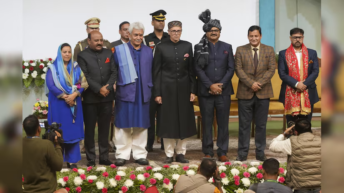|
Listen to article
Getting your Trinity Audio player ready...
|

On the 27th January, 2021, Nepal received its first batch of Covid vaccines as a grant from India under the much-vaunted Vaccine Maitri (Vaccine friendship) program. It won accolades globally as India delivered 66.36 million doses to more than 95 different countries, with Nepal being one of the foremost beneficiaries. The distribution campaign provided an impetus to the image of the world’s largest vaccine producer as a prospective global leader. Two vaccines from India (Covishield by Serum Institute of India and Covaxin manufactured by Bharat Biotech) and one from China (BBIBP-CorV Sinopharm) applied for emergency use in Nepal on 13th January, 2021. While Covishield was approved within two days, it took the Government of Nepal about a month to approve Sinopharm. Nepal’s hesitancy to procure Sinopharm stemmed from the lack of transparency in its trial results and the equivocal efficacy rate.
Fast-forward four months, both India and Nepal have been ravaged by the highly contagious new Covid variant. Strict lockdown measures have been employed by state governments in India forcing many Nepali migrants to return to Nepal. The positivity rate in Nepal is 45 percent with nearly new 9000 cases being recorded daily. Many have blamed the spiralling number of cases on Nepali workers returning from India. Desperate for vaccines and other medical supplies at home India halted the exports of their locally manufactured vaccines. After 17 years India seeks foreign aid from the international community to help its crippled health system and tackle the on-going virus. On this backdrop and with western countries’ reluctance to share vaccines, China has been provided an enabling environment to mend its global image, heed crisis responses of other countries and steadily overcome international censure.
The ban placed by the Indian government on vaccine export has left countries like Nepal and Bangladesh in the lurch. Although Nepal paid (80% payment) the Serum Institute of India (SII) for two million vaccines, only one million of two million jabs could be delivered on 21st February, 2021. People above the age of 65 still await their second dose in Nepal. According to a deal, SII was supposed to provide five million vaccines to Bangladesh per month from January to June this year. Only seven million have been delivered. As the Covid crisis continues to unfold, China gifted 500,000 Sinopharm vaccines to Bangladesh on 12th May and Nepal recently commenced administering its population with second jabs from the 800,000 donated Sinopharm vaccines that arrived on 29th March, 2021. China has donated 1.1 million Sinopharm vaccines to Sri Lanka. Uncertainty looms in Sri Lanka as there is no sign of administering the second jab to the island’s 6% of the population who have received the first jab of Covishield.
On the question of transparency and efficacy surrounding vaccines made in China, very few studies attested their safety. However, leaders of some beneficiary countries went beyond their normal diplomatic behaviour and publicly received the Chinese-made vaccines to instil confidence among their people. Pakistan Prime Minister Imran Khan, Turkish President Recep Tayyip Erdogan, Hungarian Prime Minister Victor Orban, and Indonesian President Joko Widodo were vaccinated publicly. But the approval from the World Health Organization (WHO) to include Sinopharm for emergency use under the global vaccination initiative called COVAX has given it a vital boost and international recognition. President Xi Jinping has touted that vaccines developed by China would be a ‘global public good’. This will undoubtedly earn China some much needed goodwill.
Even while battling their Covid crisis and suffering from a paucity of oxygen for its population, India managed to squeeze “two to three” oxygen tankers and 900 cylinders by road for Nepal. While Nepal will, without a doubt, appreciate this altruistic gesture, the supply is nowhere near sufficient. Meanwhile, China has provided 3,500 oxygen cylinders (1000 cylinders will arrive through the Rasuwagadhi border) and 10 ventilators. Another consignment of medical equipment (40 portable ventilators, 20 automated analyzers to name a few) worth five million RMB is soon to be handed over to Nepal at the Tatopani border. Simultaneously while delivering these medical equipment, China has already announced an additional grant of five million RMB. The Government of Sichuan Province, the Government of the Tibet Autonomous Region (TAR) and the Red Cross Society of China have also donated medical supplies which have been delivered or are in the process of being delivered.
The Serum Institute of India mentioned in a recent statement that they will only be able to export vaccines by the end of the year. On the contrary, in a video conference China’s Foreign Minister, Wang Yi, assured his counterparts from Afghanistan, Bangladesh, Nepal, Pakistan and Sri Lanka that Beijing is keen to supply them with vaccines. Bangladesh is one of the first beneficiaries of China’s commitment to providing vaccines. As India is no more the first option, countries in the region are forced to look elsewhere. The likely alternative is China as they are ramping up their relief efforts in the region. If not immediately, China has ample time to manoeuvre itself as the leading crisis responder in the region. As Nepal reels under the second wave, they haven’t been able to overcome bureaucratic hurdles and logistic hassles. A proposal furnished by the Nepal embassy in Beijing to procure additional vaccines from Sinopharm has been collecting dust at the Ministry of Health and Population (Nepal) for a little over than a week. Some have reasoned that the larger geo-politics are at play. However, there is little doubt that while some sections of the public discourse in India question the benevolent Vaccine Maitri initiative, China is striving towards filling the gap left by India.






Add comment